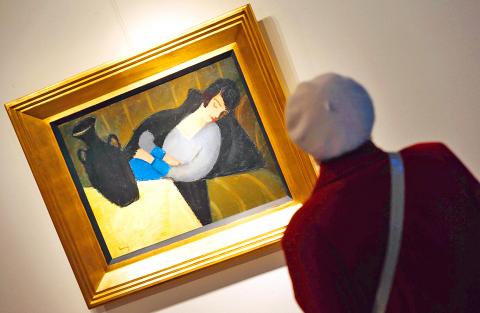A long-lost avant-garde painting has returned home to Hungary after nine decades thanks to a sharp-eyed art historian who spotted it being used as a prop in the Hollywood film Stuart Little.
In 2009 Gergely Barki, a researcher at Hungary’s National Gallery, noticed Sleeping Lady with Black Vase by Robert Bereny (1888-1953) in the 1999 kids’ movie about a mouse as he watched TV with his daughter Lola.
“I couldn’t believe my eyes when I saw Bereny’s long-lost masterpiece on the wall behind Hugh Laurie. I nearly dropped Lola from my lap,” Barki, 43, told AFP on Thursday.

Photo: AFP, Ferenc Isza
“A researcher can never take his eyes off the job, even when watching Christmas movies at home,” he said.
The painting disappeared in the 1920s but Barki recognized it immediately even though he had only seen a faded black-and-white photo dating from a 1928 exhibition archived in the National Gallery.
Barki sent a flurry of emails to staff at the film’s makers Sony Pictures and Columbia Pictures, receiving a reply from a former Sony employee, a set designer — two years later.
“She said the picture was hanging on her wall,” Barki told AFP.
“She had snapped it up for next-to-nothing in an antiques shop in Pasadena, California, thinking its avant-garde elegance was perfect for Stuart Little’s living room.”
After leaving Sony, the set-designer sold the painting to a private collector who has now brought the picture to Budapest for auction.
Bereny, the leader of a pre-World War I avant-garde movement called the “Group of Eights,” fled to Berlin in 1920 after designing recruitment posters for Hungary’s short-lived communist revolution in 1919.
In the German capital, he had a romance with actress Marlene Dietrich, and, according to Barki, a rumoured fling with Anastasia, the mysterious daughter of Russia’s last tsar Nicholas II.
Bereny’s painting goes under the hammer Dec. 13 with a starting price of around 110,000 euros (US$137,350), staff at the Virag Judit auction house told AFP.
According to Barki, the buyer at the 1928 exhibition, possibly Jewish, probably left Hungary in the run-up to, or during, World War II.
“After the wars, revolutions, and tumult of the 20th century many Hungarian masterpieces are lost, scattered around the world,” he said.

May 18 to May 24 Pastor Yang Hsu’s (楊煦) congregation was shocked upon seeing the land he chose to build his orphanage. It was surrounded by mountains on three sides, and the only way to access it was to cross a river by foot. The soil was poor due to runoff, and large rocks strewn across the plot prevented much from growing. In addition, there was no running water or electricity. But it was all Yang could afford. He and his Indigenous Atayal wife Lin Feng-ying (林鳳英) had already been caring for 24 orphans in their home, and they were in

On May 2, Chinese Nationalist Party (KMT) Chairman Eric Chu (朱立倫), at a meeting in support of Taipei city councilors at party headquarters, compared President William Lai (賴清德) to Hitler. Chu claimed that unlike any other democracy worldwide in history, no other leader was rooting out opposing parties like Lai and the Democratic Progressive Party (DPP). That his statements are wildly inaccurate was not the point. It was a rallying cry, not a history lesson. This was intentional to provoke the international diplomatic community into a response, which was promptly provided. Both the German and Israeli offices issued statements on Facebook

Even by the standards of Ukraine’s International Legion, which comprises volunteers from over 55 countries, Han has an unusual backstory. Born in Taichung, he grew up in Costa Rica — then one of Taiwan’s diplomatic allies — where a relative worked for the embassy. After attending an American international high school in San Jose, Costa Rica’s capital, Han — who prefers to use only his given name for OPSEC (operations security) reasons — moved to the US in his teens. He attended Penn State University before returning to Taiwan to work in the semiconductor industry in Kaohsiung, where he

President William Lai (賴清德) yesterday delivered an address marking the first anniversary of his presidency. In the speech, Lai affirmed Taiwan’s global role in technology, trade and security. He announced economic and national security initiatives, and emphasized democratic values and cross-party cooperation. The following is the full text of his speech: Yesterday, outside of Beida Elementary School in New Taipei City’s Sanxia District (三峽), there was a major traffic accident that, sadly, claimed several lives and resulted in multiple injuries. The Executive Yuan immediately formed a task force, and last night I personally visited the victims in hospital. Central government agencies and the